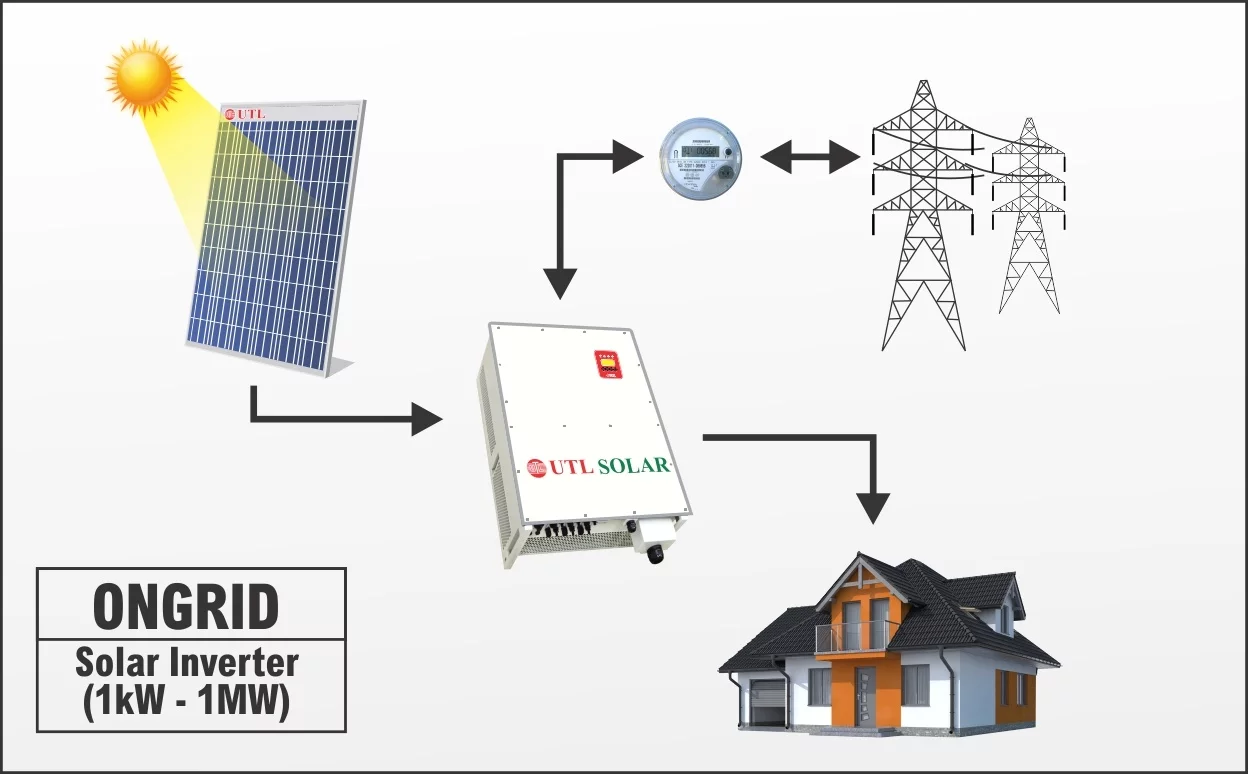Power Your Home with On-Grid Solar System
A grid-tied or grid-connected system, also known as an on-grid solar system, is a solar energy configuration that is directly connected to the electrical grid. It is a popular choice for residential, commercial, and industrial applications since it allows users to generate clean energy while keeping connected to the local power grid. This section will go over the features, benefits, and components of an on-grid solar system.

How Does an On-Grid Solar System Work?
An on-grid solar system comprises solar panels, an inverter, and a grid connection. Here's a simplified overview of how it works:
-
Solar Panels: Photovoltaic (PV) solar panels, typically installed on rooftops or in open spaces, capture sunlight and convert it into direct current (DC) electricity. The panels consist of multiple solar cells made of semiconductor materials.
-
Inverter: The DC electricity generated by the solar panels is then sent to an inverter. The inverter's primary function is to convert the DC electricity into alternating current (AC) electricity, which is the standard form of electricity used in homes and businesses.
-
Grid Connection: The AC electricity produced by the inverter is then fed into the electrical distribution panel of the building. Simultaneously, any excess electricity not immediately consumed by the building's electrical loads is sent back to the grid through a bidirectional meter.
-
Metering and Net Metering: A bidirectional meter measures both the electricity consumed from the grid and the excess electricity fed back into the grid. This enables a process called net metering, where the excess electricity is credited to the user's electricity bill or compensated by the utility company.
Benefits of On-Grid Solar Systems
-
Electricity bill Savings: By generating their own electricity, users of on-grid solar systems can significantly reduce their reliance on the grid, resulting in lower electricity bills. In some cases, excess electricity fed back into the grid can earn credits or income for the system owner.
-
Environmental Benefits: On-grid solar systems contribute to a greener environment by utilizing clean and renewable solar energy. They reduce reliance on fossil fuels and help mitigate greenhouse gas emissions, contributing to a more sustainable future.
-
Grid Backup: With on-grid solar systems, users remain connected to the grid, ensuring a reliable power supply even when solar generation is insufficient. They can draw electricity from the grid during times of high energy demand or when solar generation is low, providing a seamless power backup.
-
Easy Installation and Maintenance: On-grid solar systems are relatively straightforward to install, especially with the assistance of professional solar installers. They require less equipment and maintenance compared to off-grid systems, as there is no need for energy storage batteries.
On Grid System Price
| On Grid Solar Model | Selling Price | Price Per Watt |
|---|---|---|
| 1kW Solar System | Rs. 66,999 | Rs. 66.99 |
| 2kW Solar System | Rs. 90,990 | Rs. 45.50 |
| 3kW Solar System | Rs. 1,55,482 | Rs. 51.83 |
| 5kW Solar System | Rs. 2,32,264 | Rs. 46.45 |
| 8kW Solar System | Rs. 3,79,649 | Rs. 47.45 |
| 10kW Solar System | Rs. 4,37,480 | Rs. 43.74 |
Components of an On-Grid Solar System
-
Solar Panels: The solar panels, consisting of individual solar cells, capture sunlight and convert it into electricity.
-
Inverter: The inverter converts the DC electricity from the solar panels into AC electricity compatible with the building's electrical system and the grid.
-
Mounting System: A mounting system, such as rooftop or ground-mounted racks, securely holds the solar panels in place.
-
Electrical Wiring and Switchgear: Electrical wiring connects the solar panels, inverter, and electrical loads. Switchgear allows for the safe and efficient control of electrical power within the system.
-
Grid Connection and Metering: A grid connection enables the flow of electricity between the on-grid solar system and the local utility grid. A bidirectional meter measures the electricity consumed from and fed back into the grid.
